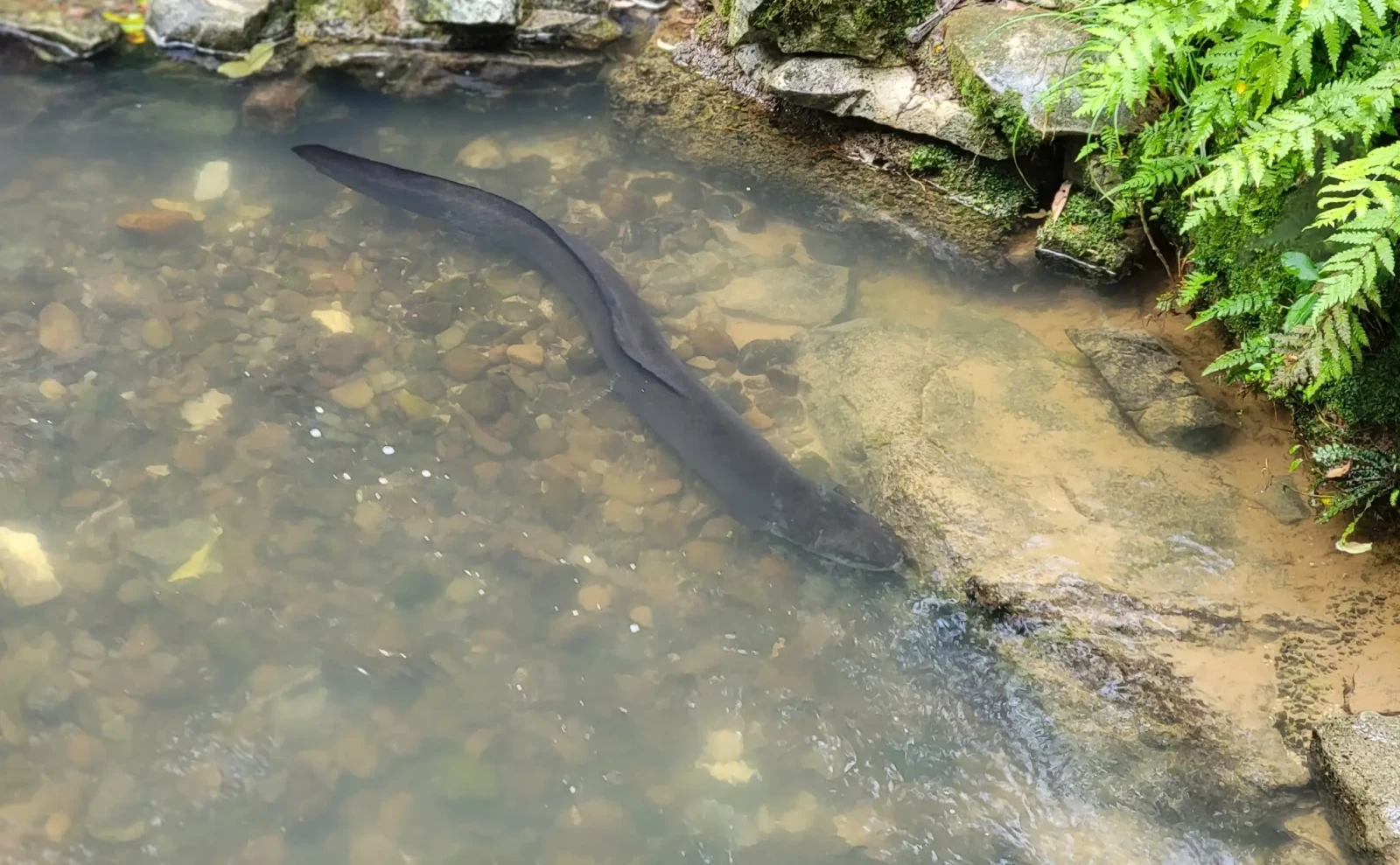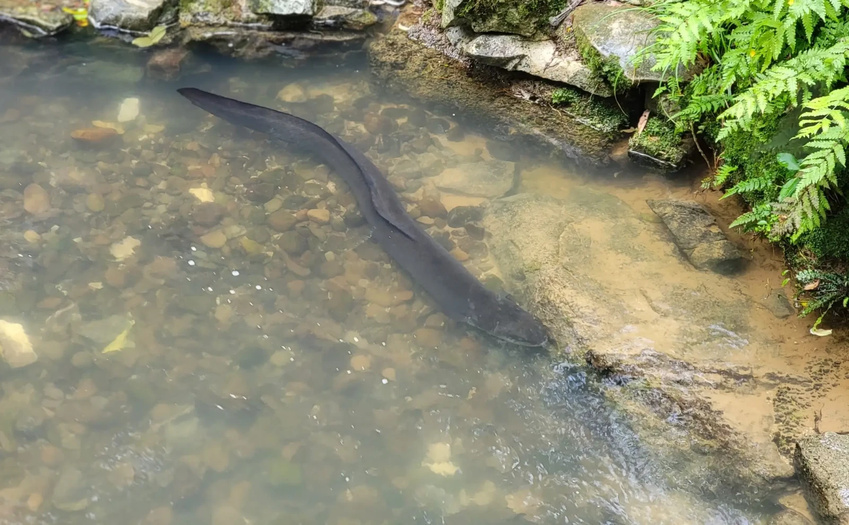A Closer Look at the American Eel
Unlike most eels that remain in saltwater for their entire lives, the American eel spends the majority of its life in freshwater before making a final journey back to the Sargasso Sea to spawn. Scientists believe this migration marks the end of their life cycle, though much about their behavior and lifecycle is still not fully understood, according to Mike Abney, a Duke Energy project manager who has spent decades working to reestablish eel populations in the Catawba-Wateree and Pee Dee rivers.
Eels aren’t the only species benefiting from these conservation efforts. Duke Energy is also working to restore American shad populations. These migratory fish follow an opposite path—hatching in freshwater rivers, maturing in the ocean, and then returning to freshwater to reproduce.
A Century in the Making
American eels once thrived in the Pee Dee River, but in 1912, the construction of a Duke Energy dam at the North Carolina–South Carolina border disrupted their migration. The dam supported regional growth by generating electricity, but it also created a barrier to fish movement.
"As the U.S. expanded its infrastructure, many rivers were modified for industrial and energy purposes, which unfortunately led to habitat loss for several species," said Jason Brown, lead Environmental Health & Safety consultant at Duke Energy.
A newly built eel ladder at the Blewett Falls Hydroelectric Station in Lilesville, N.C., is helping reverse some of that impact. So far, nearly 18,000 juvenile eels have found their way into the waters near Blewett Falls Lake.
“By reopening access to upstream habitats, we’re giving American eels a chance to reach areas they haven’t accessed in over a century,” Brown noted. “Our goal is to restore the river to its natural function as much as possible.”
How the Eel Ladder Functions
Developed in collaboration with the North Carolina Wildlife Resources Commission, the U.S. Fish and Wildlife Service, and the National Marine Fisheries Service (under NOAA), the eel ladder uses flowing water to guide eels up and over the dam.
“Eels naturally follow currents during migration,” Brown explained. “We pump water from the lake to create a current along a series of ramps. This allows the eels to climb into the lake above the dam.”
The structure includes five aluminum ramps connected by resting pools, leading into a collection tank where each eel is measured, weighed, and counted to monitor population health and migration trends. Afterward, they’re released into Blewett Falls Lake.
Eventually, the system will operate without manual intervention, allowing the eels to migrate freely—a first for Duke Energy. Eels typically spend 8 to 10 years in the lake before beginning their journey back to the Sargasso Sea.
The Return of the Shad
American shad require a more complex system for migration. “The eel ladder works on its own, needing little oversight,” Abney said. “But American shad need a more advanced approach.”
To identify the best locations for the new facilities, studies were conducted in 2015 and 2016 to determine where eels and shad gathered most often. “Without these studies, we might have placed the systems in ineffective locations,” Brown explained.
Shad are also drawn to flowing water. At the facility, fish are lifted in stages and sorted through a series of tanks by a team of scientists. The American shad are transported in a large tank by truck above the dam and released into the lake, while other species are safely returned to the river through pipes.
Real-World Conservation Efforts
Blewett Falls Lake remains a hotspot for recreational activities like boating and fishing, though any American shad caught must be released immediately.
“If someone catches a shad here, it means our system worked,” Abney noted. “And with the amount of effort going into this, we want to ensure these fish stay in the ecosystem.”
For both Abney and Brown, witnessing the return of these species has been a highlight of their careers. “Seeing large numbers of these animals using the passageways we’ve built is incredibly fulfilling,” said Brown.
Many who initiated this effort have since retired. “We knew this would take decades,” Abney recalled. “People like John Crutchfield, who helped shape the project in its early stages, have since moved on, but their impact is lasting.”
Though the project took years to implement, its positive effects will be felt for generations. “I want my kids to enjoy the same natural experiences I had,” Brown said. “This work lays the foundation for that future.”
Additional Improvements at Blewett Falls
In addition to restoring fish migration, Duke Energy has upgraded its water management at Blewett Falls Hydro Station with new spillway gates. These gates enhance operational efficiency, improve lake level control, and increase safety.
Their modular design allows for easier maintenance, while pneumatic supports ensure reliability even during power outages. They also aid in flood management by allowing floodwaters to pass safely, reducing the risk of property damage upstream.
Unlike most eels that remain in saltwater for their entire lives, the American eel spends the majority of its life in freshwater before making a final journey back to the Sargasso Sea to spawn. Scientists believe this migration marks the end of their life cycle, though much about their behavior and lifecycle is still not fully understood, according to Mike Abney, a Duke Energy project manager who has spent decades working to reestablish eel populations in the Catawba-Wateree and Pee Dee rivers.
Eels aren’t the only species benefiting from these conservation efforts. Duke Energy is also working to restore American shad populations. These migratory fish follow an opposite path—hatching in freshwater rivers, maturing in the ocean, and then returning to freshwater to reproduce.
A Century in the Making
American eels once thrived in the Pee Dee River, but in 1912, the construction of a Duke Energy dam at the North Carolina–South Carolina border disrupted their migration. The dam supported regional growth by generating electricity, but it also created a barrier to fish movement.
"As the U.S. expanded its infrastructure, many rivers were modified for industrial and energy purposes, which unfortunately led to habitat loss for several species," said Jason Brown, lead Environmental Health & Safety consultant at Duke Energy.
A newly built eel ladder at the Blewett Falls Hydroelectric Station in Lilesville, N.C., is helping reverse some of that impact. So far, nearly 18,000 juvenile eels have found their way into the waters near Blewett Falls Lake.
“By reopening access to upstream habitats, we’re giving American eels a chance to reach areas they haven’t accessed in over a century,” Brown noted. “Our goal is to restore the river to its natural function as much as possible.”
How the Eel Ladder Functions
Developed in collaboration with the North Carolina Wildlife Resources Commission, the U.S. Fish and Wildlife Service, and the National Marine Fisheries Service (under NOAA), the eel ladder uses flowing water to guide eels up and over the dam.
“Eels naturally follow currents during migration,” Brown explained. “We pump water from the lake to create a current along a series of ramps. This allows the eels to climb into the lake above the dam.”
The structure includes five aluminum ramps connected by resting pools, leading into a collection tank where each eel is measured, weighed, and counted to monitor population health and migration trends. Afterward, they’re released into Blewett Falls Lake.
Eventually, the system will operate without manual intervention, allowing the eels to migrate freely—a first for Duke Energy. Eels typically spend 8 to 10 years in the lake before beginning their journey back to the Sargasso Sea.
The Return of the Shad
American shad require a more complex system for migration. “The eel ladder works on its own, needing little oversight,” Abney said. “But American shad need a more advanced approach.”
To identify the best locations for the new facilities, studies were conducted in 2015 and 2016 to determine where eels and shad gathered most often. “Without these studies, we might have placed the systems in ineffective locations,” Brown explained.
Shad are also drawn to flowing water. At the facility, fish are lifted in stages and sorted through a series of tanks by a team of scientists. The American shad are transported in a large tank by truck above the dam and released into the lake, while other species are safely returned to the river through pipes.
Real-World Conservation Efforts
Blewett Falls Lake remains a hotspot for recreational activities like boating and fishing, though any American shad caught must be released immediately.
“If someone catches a shad here, it means our system worked,” Abney noted. “And with the amount of effort going into this, we want to ensure these fish stay in the ecosystem.”
For both Abney and Brown, witnessing the return of these species has been a highlight of their careers. “Seeing large numbers of these animals using the passageways we’ve built is incredibly fulfilling,” said Brown.
Many who initiated this effort have since retired. “We knew this would take decades,” Abney recalled. “People like John Crutchfield, who helped shape the project in its early stages, have since moved on, but their impact is lasting.”
Though the project took years to implement, its positive effects will be felt for generations. “I want my kids to enjoy the same natural experiences I had,” Brown said. “This work lays the foundation for that future.”
Additional Improvements at Blewett Falls
In addition to restoring fish migration, Duke Energy has upgraded its water management at Blewett Falls Hydro Station with new spillway gates. These gates enhance operational efficiency, improve lake level control, and increase safety.
Their modular design allows for easier maintenance, while pneumatic supports ensure reliability even during power outages. They also aid in flood management by allowing floodwaters to pass safely, reducing the risk of property damage upstream.


 Eel and Shad Migration Restored at Blewett Falls Dam
Eel and Shad Migration Restored at Blewett Falls Dam





 Companies
Companies